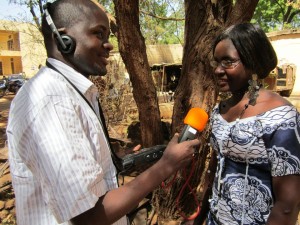Vox Pop: What’s good and bad about this journalistic format?
 Radio and TV programs are not an end in themselves – journalists don’t produce them for their own self-fulfillment, but to meet the needs of their audience. Journalists write news bulletins and reports to meet the audience’s information needs and they produce music programs to entertain their audience.
Radio and TV programs are not an end in themselves – journalists don’t produce them for their own self-fulfillment, but to meet the needs of their audience. Journalists write news bulletins and reports to meet the audience’s information needs and they produce music programs to entertain their audience.
All of these journalistic formats have one thing in common: they are produced and presented by professionals. And the other voices that appear in the sound clips are most often those of politicians, experts or high-ranking people.
The average citizen hardly ever appears on the air – unless the program uses vox pop. This expression is short for the Latin term, “vox populi” and means “the voice of the people”. When this “voice of the people” is heard, the audience knows that “normal people”, very much like themselves, also have a place in broadcasting. They feel appreciated and taken seriously by the radio or TV station. And this in turn strengthens the audience’s “loyalty” to the station.
For a “vox pop”, journalists ask a number of randomly selected people the same question, collect the answers and string them together. The different answers create an idea of the variety of opinions existing within the population.
Journalists usually conduct these “one-question interviews” in public places where you can find many different kinds of people.
A vox pop is never a representative opinion poll, but merely a random selection of responses. But as listeners love to hear what other ordinary people think, a vox pop will make any program more lively, entertaining and credible.
The duration of a good vox pop should be between one and two minutes.
A vox pop can be a good tool to raise interest in a topic. One way to use it is to confront studio guests with what average people say about a certain topic and then let them respond to the people’s views.
 Example 1:
Example 1:
After asking ordinary people on the streets of BIGTOWN how they feel about the building of a new pharmaceuticals factory, you use the answers to put together a vox pop.
Afterwards, when you conduct a studio interview with the mayor, you confront him with what the people said and refer to the vox pop in your first question: “Mr. Mayor, you have heard some of the residents’ opinions. How do you feel about these?”
Or
Example 2:
You have a report in your program about a press conference, in which the mayor and the pharmaceuticals plant PILLCO announced that the new factory would be built.
In this report, the listeners find out what the officials have to say on this topic. But they do not know what the residents of the affected neighborhood BIGTOWN think about the plans. Do they all agree with the project? Are there also critical voices? Or are the people indifferent about what is happening?
Of course you could summarize in your own words that opinion about this project is divided, that there are both positive and negative views among the population. But this way of presenting that information would be pretty boring and very original.
It would be better to give the affected people a voice in your program: let the audience hear what the people say in a vox pop, which you can broadcast after the report.
That way, the listeners and viewers get all the information on the various parties’ opinions – and it is been presented in a very authentic and lively manner.
Vox pops are an instrument to present public opinion and help make your programs more dynamic. As the people voice their opinions spontaneously, they are often emotional, angry, funny or provide unexpected insights.
The voices of average people lend your programs more authenticity and credibility. Listeners and viewers can identify with the average people they hear and see on the air. After all, these are not politicians or experts who “talk down to them”, but ordinary people – just like them.
Pros and cons of the vox pop:
| Pros | Cons |
|
The production is time-consuming
The people being interviewed may be shy and apprehensive about talking into a microphone. They may be unable to express themselves. Vox pop can not stand alone – it should always be connected to another part of the program. Is not representative |
In our next installment, we’ll discuss how to find a good topic for a vox pop and how to ask the right question.
by Peter Hüllen and Thorsten Karg




Feedback